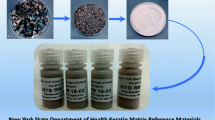Abstract
Toenails and fingernails are routinely used to estimate selenium status in epidemiological studies; however, literature validating nail selenium concentration as a surrogate for critical organs is limited. In this study diets of intact male dogs were selenium supplemented at two physiological levels (3 and 6 μg/kg/day) in two different forms, selenomethionine and selenium-enriched bioformed yeast. The selenium-adequate basal diet consumed by the treatment and control groups during the 4-week run-in period and throughout the trial contained 0.3 ppm selenium. After 7 months the dogs in the two treatment groups and the control group were euthanized. Representative tissue samples from prostate, brain, liver, heart and skeletal muscle were collected, rinsed and frozen. Toenail clippings from multiple toes were also collected. Selenium was determined by neutron activation analysis using Se77m (half life = 17.4 s) at the University of Missouri Research Reactor Center. NIST SRM 1577, Bovine Liver was analyzed as a quality control. The analysts were blinded to control and treatment group assignments. As expected, tissue selenium levels increased proportionally with supplementation. A slightly greater increase in tissue selenium was observed for the purified selenomethionine compared to the bioformed yeast; however this trend was significant only for brain tissue. Toenail selenium concentrations and tissue selenium were highly correlated (p < 0.003) with Pearson coefficients of 0.759 (skeletal muscle), 0.745 (heart), 0.729 (brain), 0.723 (prostate), and 0.632 (liver). The toenail biologic monitor accurately assesses selenium status in skeletal muscle, heart, brain, prostate, and liver in the canine model.

Similar content being viewed by others
References
Xu XM, Carlson BA, Mix H, Zhang Y, Saira K, Glass RS, Berry MJ, Gladyshev VN, Hatfield DL (2006) PLoBiol 5:e4
Kryukov GV, Castellano S, Novoselov SV, Lobanov AV, Zehtab O, Guigi R, Gladyshev VN (2003) Science 300:1439–1443
Small-Howard AL, Berry MJ (2005) Biochem Soc Trans 33:1493–1497
Recommended Daily Allowances, 10th Edition (1989) National Research Council, National Academy Press, Washington DC, pp 217–224
Dietary Reference Intakes for Vitamin C, Vitamin E, Selenium and Carotenoids (2000) National Research Council, National Academy Press, Washington DC, pp 311–318
Lipmann SM, Klein EA, Goodman PJ et al (2009) JAMA 301:39–51
Morris JS, Willett WC, Stampfer M (1983) Biol Trace Element Res 5:529–537
Hunter DJ, Morris JS, Chute CG, Kushner E, Colditz GA, Stampfer MJ, Speizer FE, Willett WC (1990) Am J Epidemiol 132:114–122
Baskett CK, Spate VL, Morris JS et al (1995) J Radioanal Nucl Chem 195:97–108
Longnecker MP, Stampfer MJ, Morris JS, Spate V, Baskett C, Mason M, Willett WC (1993) Am J Clin Nutr 57:408–413
Waters DJ, Shen S, Cooley DM, Bostwick DG, Qian J, Combs GF Jr et al (2003) JNCI 95:237–241
2000 report of the American Veterinary Medical Association Panel on Euthanasia (2001) J Am Vet Med Assoc 218:669
Veatch AE, Brockman JD, Spate VL, Robertson JD, Morris JS (2005) J Radioanal Nucl Chem 264:33–38
Morris JS, Spate VL, Ngwenyama RA (2006) J Radioanal Nucl Chem 269:283–290
Behne D, Alber D, Kyriakopoulos A (2010) J Trace Elem Med Biol 24:99–105
Author information
Authors and Affiliations
Corresponding author
Rights and permissions
About this article
Cite this article
Morris, J.S., Spate, V.L., Ngwenyama, R.A. et al. Determination of selenium status using the nail biologic monitor in a canine model. J Radioanal Nucl Chem 291, 439–444 (2012). https://doi.org/10.1007/s10967-011-1244-2
Received:
Published:
Issue Date:
DOI: https://doi.org/10.1007/s10967-011-1244-2




